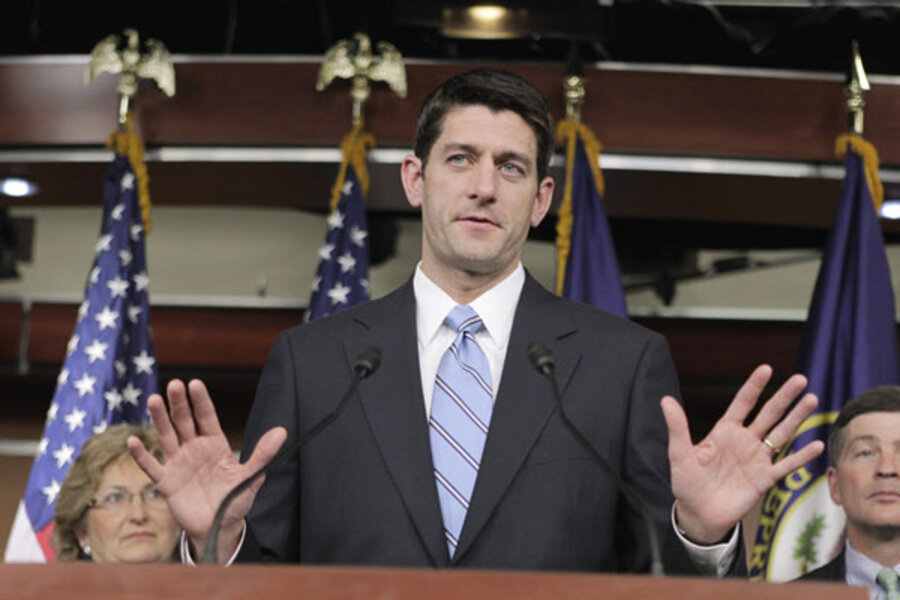US credit rating: Congress has many debt plans, but will it heed warning?
Loading...
| Washington
A report that Standard and Poor’s has lowered its US credit outlook from “stable” to “negative” jolted the New York Stock Exchange and fueled calls for Congress and the White House to come to terms on a solution to America’s soaring debt.
While maintaining its AAA rating on US debt, the rating agency added a cautionary note due to the nation’s “rising government indebtedness” – and the prospect that Congress and the White House will not deal with it. It’s a signal that if a political deal is not reached by 2013, the US credit rating could be downgraded, triggering higher interest rates and deepening the debt crisis.
“There is a material risk that US policymakers might not reach an agreement in how to address medium- and long-term budgetary challenges by 2013,” Standard and Poor’s concluded.
In response, the White House insisted that progress is being made toward a bipartisan agreement. “We think the political process will outperform S&P expectations,” said White House press secretary Jay Carney at a briefing Monday. “The fact is when the issues are important, history shows that both sides can come together and get things done,” he added.
In fact, Washington is awash with plans to rein in deficits. Last week, President Obama called for $4 trillion in deficit reduction over 12 years. Republicans call for $4 trillion over 10 years. Although those figures may be close, the approaches are starkly different.
On Friday, the House voted on five budget plans for fiscal year 2012, each with dramatically different strategies to resolve the nation’s fiscal woes. Here are details of those five plans:
• The GOP leadership plan, developed by House Budget Committee chair Paul Ryan (R) of Wisconsin, lowered both individual and corporate tax rates and capped government spending as a percentage of gross domestic product. It also significantly overhauled Medicare and Medicaid, shifting costs to individuals and the states. It passed with no Democrat votes, 235 to 193.
• Democrats on the House budget panel, led by Rep. Chris Van Hollen of Maryland, aimed to bring the budget back toward “primary balance” by fiscal year 2018 by freezing nondefense spending for five years, ending tax breaks to oil and gas industries, and not renewing the Bush-era tax cuts. It failed 166 to 259, with no Republican votes.
• GOP conservatives proposed even deeper cuts in entitlement programs: They’d increase the retirement age for Social Security to 70 and raise the eligibility age for Medicare to 67. It failed 119 to 120, with no Democratic votes. (In a last-minute maneuver, all but 16 Democrats voted “present” – a move that could have allowed the measure to defeat the more moderate Ryan proposal.)
• The Congressional Black Caucus aimed to cut deficits by nearly $3.96 trillion over 10 years, mainly by increasing revenue – ending, specifically, the Bush-era tax cuts on the wealthy. It failed 103 to 303. Seventy-five Democrats voted with all Republicans in opposition.
• The Congressional Progressive Caucus outlined the reduction of deficits by $5.7 trillion over the next 10 years, mostly by increasing taxes by some $4 trillion and cutting defense spending by $2.3 trillion. The measure failed 77 to 347, with 108 Democrats joining all Republicans in opposition.
Fiscal watchdog groups welcomed the new interest on Capitol Hill in presenting detailed plans for dealing with the debt crisis. For years, Congress has been criticized for failing to produce plans with an aim to cut deficits and spending. But the need now, the observers say, is to hammer out a political settlement.
“It’s gratifying to see lots of plans. Now it’s necessary to put out plans that are actually viable – that lend themselves to political compromise, not just to where [sponsors] sit in the world of politics,” says Maya MacGuineas, president of the Committee for a Responsible Federal Budget.
“We’ve had some really good advice from outsiders; we now need decisionmakers to start putting together a deal,” she adds.
Last week, Mr. Obama called for new House-Senate negotiations on deficit reduction, chaired by Vice President Joe Biden. Democratic leaders have announced their appointments to these talks, while Republicans so far have not.
Meanwhile in the Senate, the so-called Gang of Six continues bipartisan negotiations over deficit reduction.
"[The S&P] announcement is yet another reminder that financial markets are closely watching efforts by the President and Congress to reduce the deficit in order to promote economic recovery and create jobs,” said House Democratic leader Nancy Pelosi in a statement.





